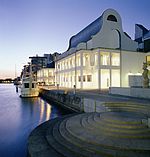Helsingborg Central Station

Helsingborg Central Station or 'Helsingborg C', also colloquially known as Knutpunkten is the primary railway station in Helsingborg. It is a transit hub for ferries, long-distance trains (SJ), Öresundståg, Pågatåg, city- and regional buses. It is one of Sweden's busiest transit hub facilities. The railway station is the eleventh largest in Sweden with 24,100 passengers per weekday (2016). This includes passengers on the ferry and bus services. In total, Knutpunkten is visited by approximately 45,000 people daily. The building is a large complex that also contains restaurants, pubs, shops and office space. Next to Knutpunkten is the contemporary Elite Hotel Marina Plaza with 197 rooms. As a railway station, it is one of the largest station buildings in Sweden and one of Sweden's eight stations with underground railway tracks in the Helsingborg Tunnel. There are two platforms underground (four tracks). There is also a platform above ground, which, however, is not in regular use but is used for parking trains. It will be opened for regular trains during 2024. The building also contains several administrative functions for the city of Helsingborg such as the City Building Administration, and since 2016 also an office hotel for business activities.
Excerpt from the Wikipedia article Helsingborg Central Station (License: CC BY-SA 3.0, Authors, Images).Helsingborg Central Station
Järnvägsgatan, Helsingborg Centrum
Geographical coordinates (GPS) Address Nearby Places Show on map
Geographical coordinates (GPS)
| Latitude | Longitude |
|---|---|
| N 56.044444444444 ° | E 12.694444444444 ° |
Address
Järnvägsgatan
252 78 Helsingborg, Centrum
Sweden
Open on Google Maps











